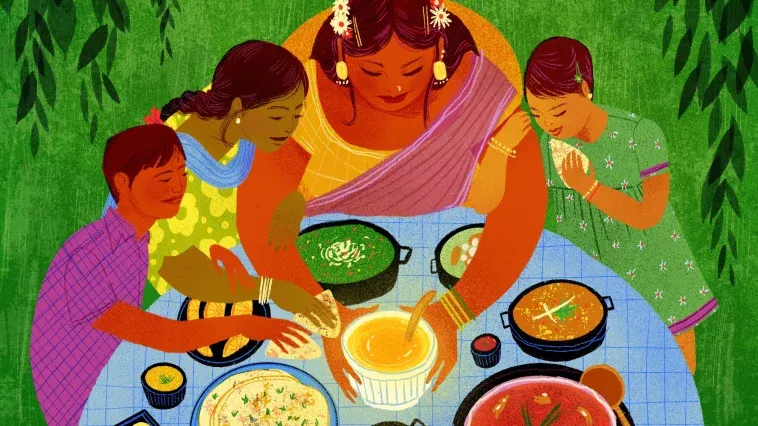(Eater) When my little one started eating solids, my pantry was overtaken by an uninterrupted supply of ghee. The sudden invasion was caused by the matriarchs of the family, who wanted to ensure that I fed the infant only homemade, rather than store-bought, ghee. Steel canisters poured in from their kitchens to ours, enough to last a few months.
Ghee holds sacrosanct value in my culture. It is used in cooking, worship, and alternative medicine. In the Indian culinary universe, ghee is a beloved cooking fat, and also a luxurious one. It is ambrosial, treasured for its nutty flavor and grainy mouthfeel. Its role in everyday as well as festive dishes is critical. Whether it’s used for a tadka, the ingenious technique of blooming whole spices in fat, or for deep-frying sweets and snacks for the gods, or as a final flourish over a bowl of khichdi or chapati, the role of ghee is so critical that traditional home cooks make sure they never run out of it.
In recent years, ghee has earned a reputation as a so-called superfood, dubbed by the health-conscious as “liquid gold.” For home cooks whose families have used ghee for generations, it’s hard to understand what the fuss is about. So let’s find out.
What exactly is ghee?
Ghee is fat. It is made by simmering butter, and then clarifying it over heat to separate out the milk solids and water. The process yields a pale yellow or amber liquid that transforms into a smooth spread once it cools and solidifies. In Bengali homes, it is allowed to caramelize until a deep brown color is achieved.
Ghee in no two households tastes the same. This is because the technique, cooking time, and even the vessel used to prepare it vary from one family to another. The quality of milk matters, and depends on the type of animal feed. Ghee in the mountainous Himalayan region, for instance, tastes different from the ghee found in the plains of Maharashtra due to the influence of terroir.
Traditionally, ghee in India is made from cow’s milk using the bilona process, which is believed to have existed since the Vedic times. It involves boiling and cooling the milk, then inoculating it with curd and leaving it to set overnight. The resulting fermented curd is then churned the next morning using a bilona, or wooden beater, to separate the butter and buttermilk. To make ghee, the butter is melted over heat until its water content has evaporated, leaving a clear residue. The process, which takes two days to complete, is now dying off due to the rise of mechanized production.
In many households, ghee is prepared with clotted cream that has been collected from the surface of full-fat milk over a period of time. Fresh yogurt is then added to the cream, which helps it turn into sour cream, usually overnight, and also gives the ghee a unique flavor. The fermented cream is then blended with cold water in order to separate out the butter. Finally, it is allowed to simmer over heat until the milk solids have settled down. The process may seem tedious, but the end result is deeply satisfying.
Since ghee has no water, it has a high smoke point (approximately 482 degrees, versus butter’s 350 degrees), which makes it ideal for cooking over high heat. Its absence of milk solids also means ghee is good for those who have dairy allergies. And because it’s shelf stable, it does not require refrigeration, a characteristic that speaks to its origins as an ingredient able to withstand India’s hot weather.
What does ghee taste like?
No, ghee does not taste like butter; it is lighter on the palate. A jar of well-made ghee has a defined nuttiness that comes from the caramelization of the milk solids. You should also be able to rub it between your fingers to test for tiny granules.
The adulation is evident in chef Shriya Shetty’s voice. “It is the ingredient for a good chicken ghee roast. Be it the caramelization of the spices or the final flavor, the dish will fall apart if the ghee is of inferior quality,” says Shetty, who is also known as the “ghee roast girl,” and spent months perfecting the fiery red Mangalorean classic for her pop-ups and workshops.
What is the history of ghee?
Ghee can be traced back to the Indus Valley Civilization from roughly 8,000 years ago. Lipid residue analysis on pottery discovered at archaeological sites suggest dairy played an important role in the local economy. At the time, buffalo milk was prized for its high fat content, and therefore most suitable for making ghee.
The Sutras, or ancient Indian texts believed to be dated from 800 BCE to 300 BCE, confirm the widespread use of ghee during festive occasions. In his book Food and Drinks in Ancient India (From Earliest Times to C. 1200 A.D.), author Om Prakash mentions madhuparka, a sweet made of honey, yogurt, or ghee that was prepared for worship or to welcome guests. Early Buddhists favored clarified butter, and it was given to convalescent monks as tonic.
Known as ghrita in Sanskrit, ghee is used as an oblation in yajna or ritual sacrifices even today. In her book Feasts and Fasts: A History of Food in India, food historian and author Colleen Taylor Sen talks about an “ode to ghee” found in the hymns in the Rig Veda:
“They pour over the fire, smiling,
Like beautiful women on their way to a festival.
The streams of butter caress the logs,
And Jatavedas, taking pleasure in them,
pays them court.
I watch them eagerly; they are like girls,
Painting themselves to go the wedding
There where the soma juice is pressed, where sacrifice is made,
The streams of butter run down to be clarified.”
Can I make ghee at home?
Absolutely. Making your own, says the Indian-born cookbook author Nandita Godbole, carries plenty of benefits: “It is free of preservatives, and holistically inclined. It is like having complete control of what you eat.” It is also cost-effective — online, an eight-ounce jar of ghee typically costs between $12 and $20. And the flavor of homemade ghee is far superior to that of most mass-produced commercial varieties.
However, due to busy lifestyles, urban Indians are switching to store-bought ghee. The huge demand means a thriving industry, where several manufacturers choose to make it with malai or cream (milk fat) instead of curd. Adulteration is common with many players relying on hydrogenated vegetable oil, and even animal fat.
But the process seems tedious. Is there an easy way out?
Get your hands on the best unsalted, cultured butter there is. It eliminates the process of making curd, which in turn saves time and effort. Godbole recommends using organic brands as they are known to have less water content, and do not splutter during the process. “Look for Amish butter, which in my experience, gives better results,” adds Godbole, who has her own recipe for making ghee.
If I do make ghee, what can I do with the leftover brown bits after straining it?
Ghee residue has a hint of crunch, and an aftertaste that’s sour in a good way. You can use it to make sweets like ladoo or barfi, but it tastes equally good on toast with a sprinkle of sugar, or on steaming hot rice with a pinch of salt. (If you want other ideas, food blogger and photographer Kankana Saxena has plenty.)
If ghee does not require refrigeration, can it go bad?
Not really. It can keep for almost a year if stored in a cool, dry spot. Refrigeration is recommended if you wish to keep it for more extended periods, or use it sparingly. No matter how you store it, always use a clean, dry spoon to scoop ghee out of the jar.






